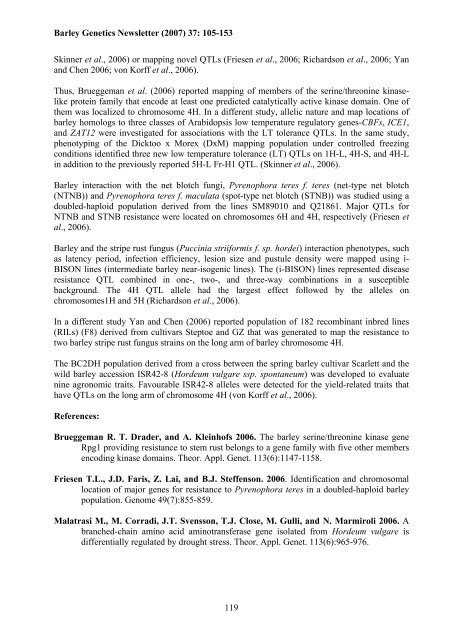BARLEY GENETICS NEWSLETTER - GrainGenes - US Department ...
BARLEY GENETICS NEWSLETTER - GrainGenes - US Department ...
BARLEY GENETICS NEWSLETTER - GrainGenes - US Department ...
Create successful ePaper yourself
Turn your PDF publications into a flip-book with our unique Google optimized e-Paper software.
Barley Genetics Newsletter (2007) 37: 105-153<br />
Skinner et al., 2006) or mapping novel QTLs (Friesen et al., 2006; Richardson et al., 2006; Yan<br />
and Chen 2006; von Korff et al., 2006).<br />
Thus, Brueggeman et al. (2006) reported mapping of members of the serine/threonine kinaselike<br />
protein family that encode at least one predicted catalytically active kinase domain. One of<br />
them was localized to chromosome 4H. In a different study, allelic nature and map locations of<br />
barley homologs to three classes of Arabidopsis low temperature regulatory genes-CBFs, ICE1,<br />
and ZAT12 were investigated for associations with the LT tolerance QTLs. In the same study,<br />
phenotyping of the Dicktoo x Morex (DxM) mapping population under controlled freezing<br />
conditions identified three new low temperature tolerance (LT) QTLs on 1H-L, 4H-S, and 4H-L<br />
in addition to the previously reported 5H-L Fr-H1 QTL. (Skinner et al., 2006).<br />
Barley interaction with the net blotch fungi, Pyrenophora teres f. teres (net-type net blotch<br />
(NTNB)) and Pyrenophora teres f. maculata (spot-type net blotch (STNB)) was studied using a<br />
doubled-haploid population derived from the lines SM89010 and Q21861. Major QTLs for<br />
NTNB and STNB resistance were located on chromosomes 6H and 4H, respectively (Friesen et<br />
al., 2006).<br />
Barley and the stripe rust fungus (Puccinia striiformis f. sp. hordei) interaction phenotypes, such<br />
as latency period, infection efficiency, lesion size and pustule density were mapped using i-<br />
BISON lines (intermediate barley near-isogenic lines). The (i-BISON) lines represented disease<br />
resistance QTL combined in one-, two-, and three-way combinations in a susceptible<br />
background. The 4H QTL allele had the largest effect followed by the alleles on<br />
chromosomes1H and 5H (Richardson et al., 2006).<br />
In a different study Yan and Chen (2006) reported population of 182 recombinant inbred lines<br />
(RILs) (F8) derived from cultivars Steptoe and GZ that was generated to map the resistance to<br />
two barley stripe rust fungus strains on the long arm of barley chromosome 4H.<br />
The BC2DH population derived from a cross between the spring barley cultivar Scarlett and the<br />
wild barley accession ISR42-8 (Hordeum vulgare ssp. spontaneum) was developed to evaluate<br />
nine agronomic traits. Favourable ISR42-8 alleles were detected for the yield-related traits that<br />
have QTLs on the long arm of chromosome 4H (von Korff et al., 2006).<br />
References:<br />
Brueggeman R. T. Drader, and A. Kleinhofs 2006. The barley serine/threonine kinase gene<br />
Rpg1 providing resistance to stem rust belongs to a gene family with five other members<br />
encoding kinase domains. Theor. Appl. Genet. 113(6):1147-1158.<br />
Friesen T.L., J.D. Faris, Z. Lai, and B.J. Steffenson. 2006. Identification and chromosomal<br />
location of major genes for resistance to Pyrenophora teres in a doubled-haploid barley<br />
population. Genome 49(7):855-859.<br />
Malatrasi M., M. Corradi, J.T. Svensson, T.J. Close, M. Gulli, and N. Marmiroli 2006. A<br />
branched-chain amino acid aminotransferase gene isolated from Hordeum vulgare is<br />
differentially regulated by drought stress. Theor. Appl. Genet. 113(6):965-976.<br />
119




